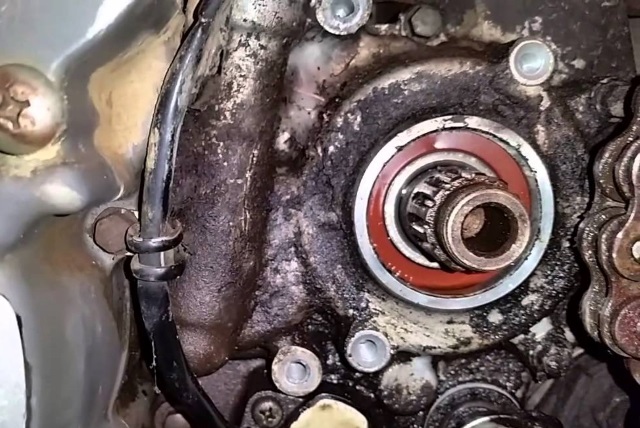
Jubilation always turns to dismay after discovering the black gold seeping through a fissure in the foundation of your garage is simply oil dripping from somewhere on your dirt bike.
Now you've got to figure out the origin of the leak.
If the puddle is small indicating a new leak your job is a bit easier but if you've not been paying attention well, good luck.
Oil leaks result from poor maintenance but as with all things mechanical time eventually wears components down. Proper maintenance like routine oil changes prolongs the misery but sooner or later the seals keeping the oil inside compartments stop performing.
Oil leaks also stem from a number of spots with the first thought directed towards the crankcase and a worn gasket. Before you do anything, wipe the oil off the bike and while you're at it, the ground too. Now start with the visual inspection to see if anything looks obvious.
The most common oil leak is behind the front sprocket which is called a countershaft seal. It is quite susceptible to dirt, wear and tear thanks to that sprocket spinning a million miles an hour, thus tends to require replacement more often than other seals. Some dirt bikes include a collar that slips over this seal that eventually grooves and/or wears the countershaft seal out. If you know what you're doing, this is an easier replacement because you don't have to split the crankcase open.
Editor's Note: This isn't a "How to replace" but rather "How to find" the oil leak.
What a mess!
You'll need to remove the chain and sprocket to get an ideal look and if the bike is a few years old or has a lot of miles on it, place your bets. But if it looks pretty clean without any residual residue check elsewhere. If time is not of the essence check back in a few hours to see if what you cleaned off is now oily again. If the leak is not dripping from the general vicinity of the collar or countershaft seal then move on.
Thanks to the drippy and oozy nature of oil don't be surprised if you're fooled into thinking the leak is the countershaft seal, only to replace it, and find the leak returns a week or so later. If this happens, then it's probably a crankcase gasket and you'll need to crack it open.
But if you rule the countershaft and crankcase seals out, check the shift shaft seals next. These suckers tend to wear as the seals oval out as a normal result from shifting. If you still haven't found the leak try the clutch covers and any other cover that requires some type of seal or gasket. For example, the outer clutch cover uses an O-ring or gasket that is easy to damage or twist during installation which eventually leaks.
The bottom line - Bad seals and gaskets produce 99 percent of visible oil leaks:
- Countershaft seal
- Shift Shaft seal
- Oil Filter Cover O-ring/gasket
- Timing chain tensioner O-ring/gasket
- Outer Clutch cover O-ring/gasket
On 2-strokes be especially wary of internal crank seals because you can't see them. This can be catastrophic for your engine because it might run lean by sucking air from the stator side or run rich by sucking clutch oil on the clutch side. Check for premix residue under the stator cover as a clue for an internal leak.
On 4-strokes, especially Hondas, check the O-ring on the oil filter cover. Unfortunately when changing the oil filter you can tighten it too much. There's a sweet spot - so too loose or too tight causes a leak.
Finally, the washer for the oil drain plug (usually a copper washer) can leak if not replaced after every oil change. You're probably already familiar with a similar gadget when changing the car oil. You can probably get away with using the same washer for two or three oil changes but many riders forget until that messy puddle shows up. The good thing though is it's an easy find and easy fix.
One more bit of advice, whenever you rebuild the engine, replace the gasket. It's probably time anyway at this point but simply opening the crankcase to get at the pistons and rods weakens the gasket so be sure to invest in a kit that includes a seal or get one separately. Don't ever reuse cylinder and cylinder head gaskets.









